Introduction To Broadband
In less than half a century, fiber optics has revolutionized
communications and in many ways, society in general. Broadband, what
many today call high speed Internet access, has become a necessity for
everyone, not a luxury. The technology that makes broadband possible is
fiber optics, connecting the continents, cities, and just about
everybody. Even fiber to the home (FTTH) brings broadband to hundreds of
millions worldwide.
How did we get from an era when communications was just making a
telephone call or sending a telegram to today’s world where every piece
of information – and misinformation – is available at the click of a
mouse or touch on a screen? How did we get from a time when a phone was
connected on copper wires to being able to connect to fiber optics at
home or practically anywhere on a handheld wireless device?
How does all this broadband work? Without fiber optics it would not
work. These web pages will explain not only how fiber broadband works,
but how it was developed. It is perhaps as much about history as
technology.
What Is Broadband?
Ever wonder about the origin of "broadband"? If you look at some of the
millions of links you get from an Internet search for “broadband,”
almost every link has a different definition according to their
viewpoint. Here’s the “first-hand” story from some of the people who
participated in the beginnings of broadband.
In February 1997 in the suburbs of Boston, Massachusetts, the first
consumers were connected to the Internet with what we call "broadband"
today.
Up to that point, most users connected to the Internet with "dial-up"
modems on a POTS (plain old telephone service) copper line. Dial-up
connection speeds at the time were mainly 14.4 kilobits per second or 56
kilobits per second. Yes, kilobits per second - thousands of bits per
second. The only alternatives for digital phone connections was T1
service at 1.544 megabits/second and thousands of dollars per
month connection fees. ISDN (Integrated Services Digital Network) over
copper phone wires had been announced but was rarely available and faded
quickly.
The innovation that introduced "broadband" Internet access to the
consumer was the Cable Modem, developed in the Boston, Massachusetts
area by Rouzbeh Yassini at Applitek. Yassini turned Applitek into
LanCity to manufacture the cable modem for CATV companies.
The original Applitek design was a networking system using coax cable
and FM (frequency modulation), a technique then called "broadband".
Yassini realized the commonality of design with CATV systems and
developed a system to put data on spare channels of a CATV system and
the cable modem as created. It became the industry standard, DOCSIS,
Data Over Cable Service Interface Specification.
The actual LanCity hardware is
shown in the photo below. The engineer is holding the first LanCity
cable modem installed in homes in 1997. The large PC case is one of the
original prototypes. The video gives an insider's story of the
development.

Gene O'Neill tells the story of working with
Lancity to develop the cable modem. The big box was the prototype tested
on a school I-Net (institutional network) coax cable TV system.
The smaller gray box he is holding is what was installed in the first
homes by
Continental Cablevision in February 1997. Watch the Video on YouTube.
The T1 line from the phone company and most other networks like Ethernet
were AM (amplitude modulation) systems commonly called "baseband"
systems. When a broadband network like CATV with cable modems became the
source of high data rate Internet access, broadband became synonymous
with high bandwidth. Today broadband refers to any high bandwidth
network. Fiber broadband is probably redundant since no high bandwidth
network runs without fiber optics.
CATV companies were already making another revolutionary change. The
scientists at Bell Labs developed a new type of laser, the distributed
feedback (DFB) laser that was capable of reproducing CATV signals
optically. CATV companies began replacing their coax backbones with
fiber optics in what they called a hybrid fiber-coax (HFC) network. The
HFC network was more reliable (a problem of coax CATV networks) and
allowed CATV networks to cover larger areas.
The combination of the large numbers of homes already subscribers to
CATV and the technologies of HFC networks and cable modems made
broadband a reality to many subscribers very quickly. This allowed CATV
companies to dominate the Internet provider market for decades.
The telcos tried to match cable modem speeds over their twisted pair
wires but with little success. The development of digital subscriber
line (DSL) lasted through more than 20 generations of standards and
still has advocates today, although most major telcos have abandoned it
in favor of fiber to the home (FTTH.) DSL was never going to be able to
keep up because of the physics of transmitting electrical signals over
the telco twisted pair wires.
Fiber to the home (FTTH) became economically feasible in the early 2000s
with the development of the passive optical network (PON) using
inexpensive optical splitters to replace expensive electronic
switches. Today, hundreds of millions of subscribers worldwide are
connected on FTTH.
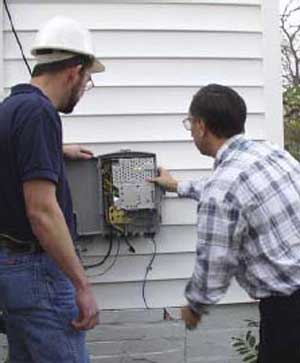
Here are two techs installing an early FTTH system on a home.
Fiber to the home is considered the ultimate
solution to provide broadband for today and the foreseeable future, but
the CATV companies have not been standing still. From the original cable
modem speeds of 4 Mb/s, they have developed new cable modem technology
that can now do gigabit speeds for downloads but are more limited in
upload speeds. Most CATV companies have experimented with and are
prepared to move to FTTH when necessary.
Today, the term “broadband” has become synonymous with high-speed
Internet, but few know that it comes from the technology behind our
first high-speed, always-on Internet.
Fiber Broadband Jargon
The key to understanding any technology is understanding the language of
the technology – the jargon. We’ve started this book with an overview
of fiber jargon to introduce you to the language of fiber
broadband and help you understand what you will be reading about
in the book.
What is Broadband?
Broadband today means networks that offer high-speed always-on Internet
access, provided by fiber to the home (FTTH), CATV cable modems or
wireless networks like 5G. The term broadband comes from the early
networks that used coax cable because of its higher bandwidth capability
and sent signals on frequency channels. Over time, it came to mean any
high-speed always-on Internet network.
Fiber Broadband means broadband delivered on fiber optics. Fiber
broadband offers much more bandwidth for broadband that other options.
But in fact, all communications are based on fiber optics; even the
wireless options use fiber optics for all connections except the final
short link to the user’s smartphone, tablet or other wireless device.
What Is A Network?
A network is a communications system shared among many users. The phone
system and the telegraph system before that were networks. A CATV system
in a network. The Internet developed from the earliest attempts to
connect computers at many locations.
What Is The Internet?
That’s not easy to define in a short paragraph, but the Internet is the
worldwide communications system used today to allow voice, data and
video communications.
What Is Fiber Optics?
Fiber optic communications means sending signals from one location to
another in the form of modulated light guided through hair-thin fibers
of glass or plastic. These signals can be either analog or digital and
transmit voice, data or video. Fiber can transport more information
longer distances in less time than any copper wire or wireless method.
It’s powerful and very fast - offering more bandwidth and distance
capability than any other form of communication! That also makes it the
most economical means of communication.
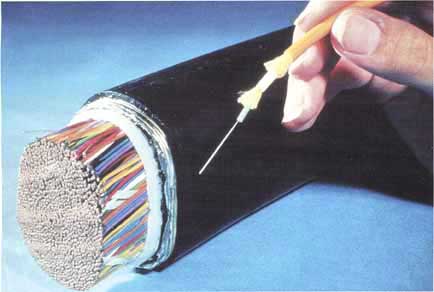
This photo from the late 1970s shows copper and fiber optic cables of
equal capacity at that time. It illustrates the advantage of fiber so
well. The bandwidth and distance capability of fiber means that fewer
cables, fewer repeaters, less power and less maintenance are needed.
Even when fiber was first being deployed, the cost of communications on
fiber optics was only a few percent of the cost on copper wires or
wireless.
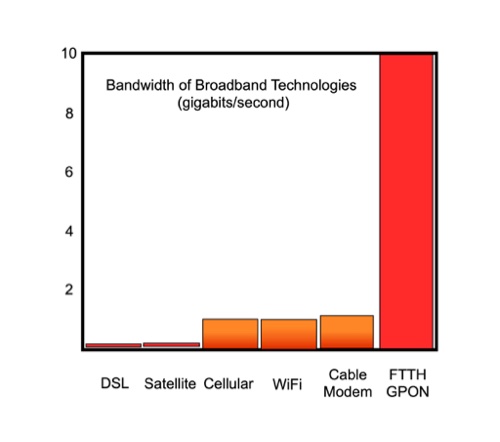
This graph comparing the relative bandwidth available in various
communications media shows how fiber provides much higher bandwidth than
any other option. The bandwidth and distance capabilities of fiber
optics makes it the medium of choice for every communications network,
from connecting homes to spanning continents.
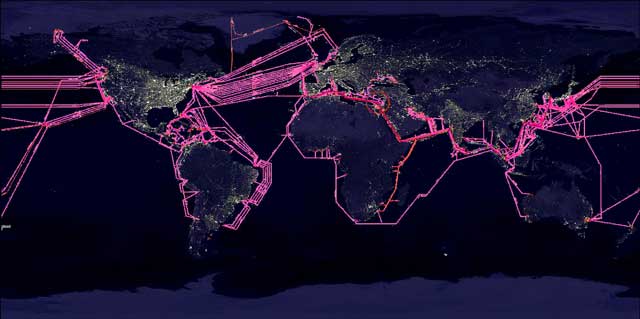
For more information on fiber optics in general, go to the FOA Guide section on Basic Fiber Optics.
More FOA Resources On Broadband
FOA Guide To Fiber Broadband
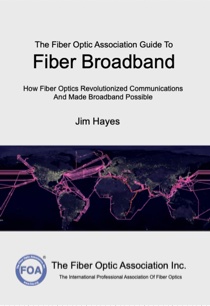 How does broadband work? Without fiber optics it would not work; even wireless has a fiber backbone.
This book is not the typical FOA technical textbook - it is written for
anyone who wants to understand fiber broadband or fiber optics or the
Internet. It's also aimed at STEM teachers who want to include
communications technology in their classes. This book will try to
explain not only how fiber broadband works, but how
it was developed. It is intended to be an introduction to
communications technology
appropriate for a communications course at almost any level (junior
high, high school or
college,) for managers involved with broadband projects, or for anyone
who just wonders how all this stuff works. How does broadband work? Without fiber optics it would not work; even wireless has a fiber backbone.
This book is not the typical FOA technical textbook - it is written for
anyone who wants to understand fiber broadband or fiber optics or the
Internet. It's also aimed at STEM teachers who want to include
communications technology in their classes. This book will try to
explain not only how fiber broadband works, but how
it was developed. It is intended to be an introduction to
communications technology
appropriate for a communications course at almost any level (junior
high, high school or
college,) for managers involved with broadband projects, or for anyone
who just wonders how all this stuff works.
The Fiber Optic Association Guide To Fiber Broadband Paperback ($12.95) and Kindle ($9.95) versions available from Amazon or most booksellers. Kindle version is in color!
The
Fiber Optic Association Fiber To The Home Handbook
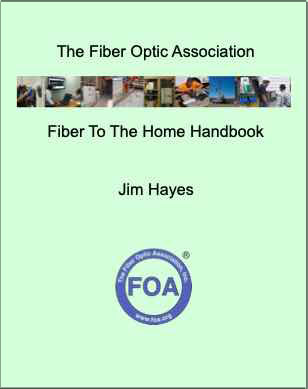 For
Planners, Managers, Designers, Installers And Operators Of
FTTH - Fiber To The Home - Networks For
Planners, Managers, Designers, Installers And Operators Of
FTTH - Fiber To The Home - Networks
This
book is a compilation of all the FTTH materials from the FOA Guide and
FTTH CFOS/H certification curriculum with additional materials covering
project design and management. The FOA materials come from almost two
decades of experience with FTTH including developing training curriculum
for training techs for the earliest commercial installations of FTTH
and consulting with many diverse FTTH projects.
This handbook is written to provide the technical information that can
help a service provider understand how to start a FTTH project or a
local organization decide if they want to create a do-it-yourself FTTH
project run by their local government, electrical coop or a
public-private partnership.
The
Fiber Optic Association Fiber To The Home Handbook
Available in paperback or as an eBook on the Amazon
Kindle Available
direct from Amazon.com,
local booksellers and other distributors.
- Technical
Information on FTTX From The FOA
Online Guide:
- FTTH
Introduction
- Training
& Certification
Fiber
U Online FTTx Self Study Program (free)
Internet Resources For Broadband
Table of Contents: The
FOA Reference Guide To Fiber Optics
|

